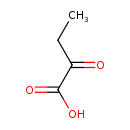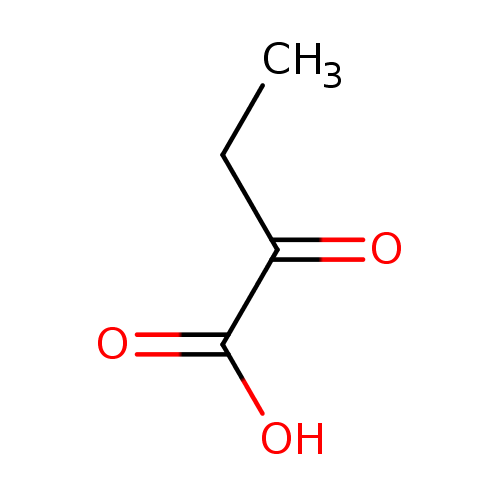|
Record Information |
|---|
| Version |
1.0 |
|---|
| Update Date |
1/22/2018 11:54:54 AM |
|---|
|
Metabolite ID | PAMDB110769 |
|---|
|
Identification |
|---|
| Name: |
2-oxobutanoate |
|---|
| Description: | A 2-oxo monocarboxylic acid anion that is the conjugate base of 2-oxobutanoic acid, obtained by deprotonation of the carboxy group. |
|---|
|
Structure |
|
|---|
| Synonyms: | -
2-oxobutyrate
-
2-ketobutyrate
-
2-oxobutyric acid
-
α-oxobutyric acid
-
α-ketobutyrate
-
α-ketobutyric acid
-
2-oxo-butyrate
-
2-keto-butyrate
-
2-ketobutyric acid
-
a-ketobutyric acid
|
|---|
|
Chemical Formula: |
C4H5O3
|
|---|
| Average Molecular Weight: |
101.08 |
|---|
| Monoisotopic Molecular
Weight: |
102.0316940589 |
|---|
| InChI Key: |
TYEYBOSBBBHJIV-UHFFFAOYSA-M |
|---|
| InChI: |
InChI=1S/C4H6O3/c1-2-3(5)4(6)7/h2H2,1H3,(H,6,7)/p-1 |
|---|
| CAS
number: |
600-18-0 |
|---|
| IUPAC Name: | 2-oxobutanoate |
|---|
|
Traditional IUPAC Name: |
2-oxobutanoic acid |
|---|
| SMILES: | CCC(=O)C(=O)[O-] |
|---|
|
Chemical Taxonomy |
|---|
|
Taxonomy Description | This compound belongs to the class of organic compounds known as short-chain keto acids and derivatives. These are keto acids with an alkyl chain the contains less than 6 carbon atoms. |
|---|
|
Kingdom |
Organic compounds |
|---|
| Super Class | Organic acids and derivatives |
|---|
|
Class |
Keto acids and derivatives |
|---|
| Sub Class | Short-chain keto acids and derivatives |
|---|
|
Direct Parent |
Short-chain keto acids and derivatives |
|---|
| Alternative Parents |
|
|---|
| Substituents |
- Short-chain keto acid
- Alpha-keto acid
- Alpha-hydroxy ketone
- Ketone
- Monocarboxylic acid or derivatives
- Carboxylic acid
- Carboxylic acid derivative
- Organic oxygen compound
- Organic oxide
- Hydrocarbon derivative
- Organooxygen compound
- Carbonyl group
- Aliphatic acyclic compound
|
|---|
| Molecular Framework |
Aliphatic acyclic compounds |
|---|
| External Descriptors |
|
|---|
|
Physical Properties |
|---|
| State: |
Solid |
|---|
| Charge: | -1 |
|---|
|
Melting point: |
33 °C |
|---|
| Experimental Properties: |
| Property | Value | Reference |
|---|
| Melting Point | 33 °C | Not Available | | Boiling Point | Not Available | Not Available | | Water Solubility | 119 mg/mL | Not Available | | LogP | Not Available | Not Available |
|
|---|
| Predicted Properties |
|
|---|
|
Biological Properties |
|---|
| Cellular Locations: |
Not Available |
|---|
| Reactions: | |
|---|
|
Pathways: |
|
|---|
|
Spectra |
|---|
| Spectra: |
| Spectrum Type | Description | Splash Key | |
|---|
| GC-MS | GC-MS Spectrum - GC-EI-TOF (Pegasus III TOF-MS system, Leco; GC 6890, Agilent Technologies) | splash10-0gbj-1900000000-8daa299f5bc38a7f9b3e | View in MoNA |
|---|
| GC-MS | GC-MS Spectrum - GC-EI-TOF (Pegasus III TOF-MS system, Leco; GC 6890, Agilent Technologies) | splash10-014s-1910000000-d01bcd7b41fdcc634eea | View in MoNA |
|---|
| GC-MS | GC-MS Spectrum - GC-MS (1 MEOX; 1 TMS) | splash10-000i-9200000000-3b3816ffee5771215904 | View in MoNA |
|---|
| GC-MS | GC-MS Spectrum - GC-MS (1 MEOX; 1 TMS) | splash10-000i-6910000000-5b264d5f7e53f3e80b12 | View in MoNA |
|---|
| GC-MS | GC-MS Spectrum - GC-MS (2 TMS) | splash10-001i-6950000000-db7f6a0f03a8cce59bae | View in MoNA |
|---|
| Predicted GC-MS | Predicted GC-MS Spectrum - GC-MS | Not Available |
|---|
| LC-MS/MS | LC-MS/MS Spectrum - Quattro_QQQ 10V, Negative (Annotated) | splash10-0pb9-9600000000-53ebb7164f74d7d92a4d | View in MoNA |
|---|
| LC-MS/MS | LC-MS/MS Spectrum - Quattro_QQQ 25V, Negative (Annotated) | splash10-0zfr-5900000000-1db864754705beb79b55 | View in MoNA |
|---|
| LC-MS/MS | LC-MS/MS Spectrum - Quattro_QQQ 40V, Negative (Annotated) | splash10-0udi-9800000000-5ba5b9ede5b1bc389b87 | View in MoNA |
|---|
| LC-MS/MS | LC-MS/MS Spectrum - LC-ESI-QTOF (UPLC Q-Tof Premier, Waters) , Negative | splash10-0udi-0900000000-bfdcad5bc3ed586bdede | View in MoNA |
|---|
| Predicted LC-MS/MS | Predicted LC-MS/MS Spectrum - 10V, Positive | splash10-0k9i-9400000000-0061f4635858d851f127 | View in MoNA |
|---|
| Predicted LC-MS/MS | Predicted LC-MS/MS Spectrum - 20V, Positive | splash10-0a4r-9100000000-b943445194fb5f8e3a0f | View in MoNA |
|---|
| Predicted LC-MS/MS | Predicted LC-MS/MS Spectrum - 40V, Positive | splash10-0a4i-9000000000-bc5920b9bd140be6b06d | View in MoNA |
|---|
| Predicted LC-MS/MS | Predicted LC-MS/MS Spectrum - 10V, Negative | splash10-0udi-5900000000-f7dfb4554f0b9e1499c9 | View in MoNA |
|---|
| Predicted LC-MS/MS | Predicted LC-MS/MS Spectrum - 20V, Negative | splash10-0a59-9200000000-e54106ad5bf45a9f072c | View in MoNA |
|---|
| Predicted LC-MS/MS | Predicted LC-MS/MS Spectrum - 40V, Negative | splash10-0a4i-9000000000-7bbba57578cf720974e3 | View in MoNA |
|---|
| 1D NMR | 1H NMR Spectrum | Not Available |
|---|
| 1D NMR | 1H NMR Spectrum | Not Available |
|---|
| 1D NMR | 13C NMR Spectrum | Not Available |
|---|
| 2D NMR | [1H,13C] 2D NMR Spectrum | Not Available |
|---|
|
|---|
|
References |
|---|
| References: |
- Sprague CL, Elfarra AA: Detection of carboxylic acids and inhibition of hippuric acid formation in rats treated with 3-butene-1,2-diol, a major metabolite of 1,3-butadiene. Drug Metab Dispos. 2003 Aug;31(8):986-92. [12867486 ]
- Yaegaki K, Sanada K: Biochemical and clinical factors influencing oral malodor in periodontal patients. J Periodontol. 1992 Sep;63(9):783-9. [1474480 ]
- Yaegaki K, Sanada K: Effects of a two-phase oil-water mouthwash on halitosis. Clin Prev Dent. 1992 Jan-Feb;14(1):5-9. [1499240 ]
- Yang W, Roth KS: Defect in alpha-ketobutyrate metabolism: a new inborn error. Clin Chim Acta. 1985 Jan 30;145(2):173-82. [3918815 ]
|
|---|
| Synthesis Reference: |
Figge, Rainer; Lux, Fabien; Raynaud, Celine; Soucaille, Philippe. Production of a-ketobutyrate by engineered Escherichia coli.PCT Int. Appl. (2006), 31pp. |
|---|
| Material Safety Data Sheet (MSDS) |
Not Available |
|---|
|
Links |
|---|
| External Links: |
|
|---|


